Varied difficulty levels in AP Inter 1st Year Zoology Model Papers and AP Inter 1st Year Zoology Question Paper March 2016 cater to students with diverse academic strengths and challenges.
AP Inter 1st Year Zoology Question Paper March 2016
Time : 3 Hours
Max. Marks: 60
General Instructions:
Note : Read the following instructions carefully.
- Answer All questions of Section – A. Answer any six questions in Section – B and answer any two questions in Section – C.
- In Section – A. questions from Sr. Nos. 1 to 10 are of Very Short Answer Type. Each question carries two marks. Every answer may be limited to 5 lines. Answer all these questions at one place in the same order.
- In Section – B, questions from Sr. Nos. 11 to 18 are of Short Answer Type. Each question carries four marks. Every answer may be limited to 20 lines.
- In Section – C, questions fromSr. Nos. 19 to 21 are of Long Answer Type. Each question carries eight marks. Every answer may be limited to 60 lines.
- Draw labelled diagrams wherever necessary in Sections – B and C.
Section – A (10 × 2 = 20)
Note : Answer all the questions in 5 lines each.
Question 1.
What is meant by tautonymy ? Give two examples.
Answer:
The practice of naming the animals, in which the generic name and species name are the same, is called tautonymy. So the name is called tautonymy. Eg : Naja naja (Indian Cobra), Axis axis (spotted deer)
Question 2.
Why is the true coelom considered a secondary body cavity ?
Answer:
During the embryonic development of the eucoelomates the blasto coel is replaced by coelom derived from the mesoderm vitrue. So, the true coelom is also called ‘Secondary bodycavity”.
Question 3.
Mention any two substances secreted by mast cells with their functions.
Answer:
- Heparin – an anticoagulant (prevents blood clotting).
- Histamine – vasodilators (cause inflammation in response to injury and infection).
Question 4.
What is the strongest cartilage ? In which regions of the human body, do you find it ?
Answer:
Fibrous cartilage is the strongest of all types of cartilage. It occurs in the intervertebral discs and public symphysis of the pelvis.
![]()
Question 5.
Which arthropod, you have studied, is called a “living fossil”? Name its respiratory organ.
Answer:
Limulus (king crab) belonging to class xiphisura of sub phylum Chelicerata is called living fossil. Its respiratory organs are book gills.
Question 6.
Name two poisonous and nonpoisonous snakes found in south India.
Answer:
- Two poisonous snakes found in south India are a) Naja naja (cobra) b) Bungarus (krait)
- Two non poisonous snakes found in south India are a) Ptyas (rat snake) b) Tropidonotus (pond snake).
Question 7.
Distinguish between lobopodium and filopodium. Give an example of each.
Answer:
a) Blunt finger like pseudopodia are called lobopodium and are seen in Amoeba and Entamoeba.
b) Fibre like pseudopodia are called filopodium and are seen in Euglypha.
Question 8.
What is a kinety ?
Answer:
A longitudinal row of kinetosomes together with kinetodesmata constitute a unit called kinety.
Question 9.
From which substances ‘Smack’ and ‘Coke’ are obtained ?
Answer:
a) Smack is chemically di acetyl morphine obtained by the acetylation of morphine extracted from dried latex of unripe seed capsule of poppy plant.
b) Coke or crack is obtained from coca plant Erythroxylum cocacommonly called cocaine.
Question 10.
Which air pollutants are mainly responsible for acid rains ?
Answer:
Sulphur dioxide and nitrogen oxides are the major causes of acid rains.
![]()
Section – B (6 × 4 = 24)
Note : Answer any six questions in 20 lines each.
Question 11.
What is the ‘evil quartet’ ?
Answer:
The following are the four major causes for accelerated rates of species extinction in the world. These causes are referred to as evil quartet.
a) Habitat loss and fragmentation : These are most important reasons for the loss of biodiversity.
b) Over exploitation : When need turns to greed, it leads to over exploitation.
c) Invasion of Alien species : When Alien species are introduced into a habitat, they turn invasive and establish themselves at the cost of indigenous species.
d) Co – extinctions : In an obligate association between a plant and an animal, if a plant becomes extinct, the animal also becomes extinct as seen in a parasitic and host association.
Question 12.
Explain Haversian system.
Answer:
In a bone between the outer and inner circumferential lamellae, there are many Haversian systems. The spaces between the Haversian systems are filled with interstitial lamellae. Haversian system consists of a Haversian canal that runs parallel to the marrow cavity. It contains an artery, a vein and a lymphatic vessel. Haversian canal is surrounded by concentric lamellae. Small fluid filled spaces called ‘lacunae’ provided with minute canaliculi lie in between the lamellae. Canaliculi connect the lacunae with one another and with Haversian canal. Each lacuna encloses one osteocyte (inactive form of osteoblast).
The cytoplasmic processes of osteocytes extend through canaliculi. A Haversian canal and the surrounding lamellae and lacunae are collectively called a Haversian system or osteon. The Haversian canals communicate with one another, with the periosteum and also with the marrow cavity by transverse or oblique canals called Volkmanns canals. Nutrients and gases diffuse from the vascular supply of Haversian canals.
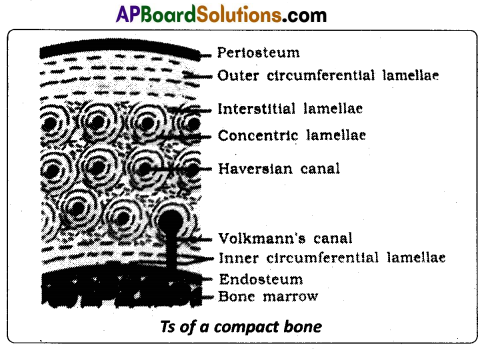
Question 13.
Write the salient features of the anthozoans.
Answer:
Class – Anthozoa or Actinozoa :
- They are commonly referred to as sea anemones.
- They are sedentary and only polypoid in form.
- Coelenteron is divided into several compartments by vertical septa called mesenteries. Adamsia (sea anemone)
- Mesoglea contains connective tissue.
- Cnidocytes occur both in the ectoderm and endoderm.
- Germ cells are derived from the endoderm.
Examples: Adamsia (sea anemone), Corailium rubrum (precious red stone coral), Gorgonia (sea fan), Pennatula (sea pen).
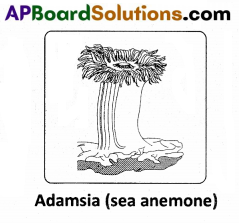
![]()
Question 14.
Compare and contrast cartilaginous and bony fishes.
Answer:
| Cartilaginous fishes | Bony fishes |
| 1) Caudal fin is heterocercal | 1) Caudal fin is diphycercal or homocercal. |
| 2) Scales if present placoid scales. | 2) Scales are ganoid, cycloid or ctenoid scales. |
| 3) Endoskeleton is entirely cartilage. | 3) Endoskeleton is bony. |
| 4) Mouth and nostrils are ventral. | 4) Mouth is usually terminal. |
| 5) Digestive tract opens into cloaca, If present. | 5) Digestive tract opens out by anus. |
| 6) Air bladder is absent. | 6) Air bladder Is often present. |
| 7) Fertilization is internal. Mostly viviparous, e.g : Scoliodon. | 7) Fertilization is external. Mostly oviparous, e.g: Catla catla |
Question 15.
What are the adverse effects of tobacco ?
Answer:
Effect : Smoking increases the carbon monoxide (CO) level and reduces the oxygen level in the blood. Nicotine stimulates the adrenal gland to release adrenaline and nor-adrenajine into blood.
These hormones raise the blood pressure and increase the heart rate. Smoking is associated with bronchitis, emphysema, coronary heart disease, gastric ulcer and increases the incidence of cancers of throat, lungs, urinary bladder etc. Smoking also paves the way to hard drugs. Yet smoking is very pravalent in society, both among young and old. Tobacco chewing is associated with increased risk of cancer of the oral cavity.
Question 16.
Discuss the causes and effects of “Global Warming”. What measures need to be taken to control “Global Warming” ?
Answer:
Global warming is causing climate changes and is “ilso responsible for the melting of polar ice caps and other snow caps of mountains such as the Himalayas. Over many years, this will result in a rise in sea levels all over the world that can submerge many coastal areas. The total spectrum of changes that global warming can bring about is a subject that is still under active research.
Global warming – Control measures :
- The measures include cutting down use of fossil fuels
- Improving efficiency of energy usage .
- Planting of trees, and avoiding deforestation
- Slowing down the growth of human population.
Section – C (2 × 8 = 16)
Note : Answer any two questions in 60 lines each.
Question 17.
Describe the life cycle of plasmodium vivax in mosquito.
Answer:
Life cycle of Plasmodium in mosquito (The mosquito phase) Ross cycle : When a female Anopheles mosquito bites and sucks the blood of a malaria patient, the gametocytes along with the other stages of the erythrocytic cycle reach the crop of mosquito. Here all the stages are digested except the gametocytes. Further part of the life cycle consists of:
i) Gametogony
ii) Fertilization
iii) Formation of ookinete & oocysts
iv) Sporogony
i) Gametogony : The formation of male and female gametes from the gametocytes is called gametogony. It occurs in the lumen of the crop of mosquito.
Formation of male gametes : During this process, the nucleus of microgametocyte divides into eight daughter nuclei called pronuclei which reach the periphery. The cytoplasm is pushed out in the form of eight flagella like processes. Into each flagellum like process, one pronucleus enters and forms a micro gamete or male gamete. These male gametes show lashing movements like flagella and get separated from the cytoplasm of microgametocyte. This process is called exflagellation.
Formation of female gamete: The female gametocyte undergoes a few changes and transforms into a female gamete. This process is called maturation. The nucleus of the female gamete moves towards the periphery and the cytoplasm at that point forms a projection. This projected region is called the fertilization cone.
ii) Fertilization: The fusion of male and female gametes is called fertilization. It also occurs in the lumen of the crop of the mosquito. When an actively moving male gamete comes into contact with the fertilization cone of the female gamete, it enters it. The pronuclei and cytoplasm of these two gametes fuse with each other, resulting in the formation of a synkaryon. Since the two gametes are dissimilar in size, this process is known as anisogamy. The female gamete that bears the synkaryon is called the zygote which is round and non – motile.
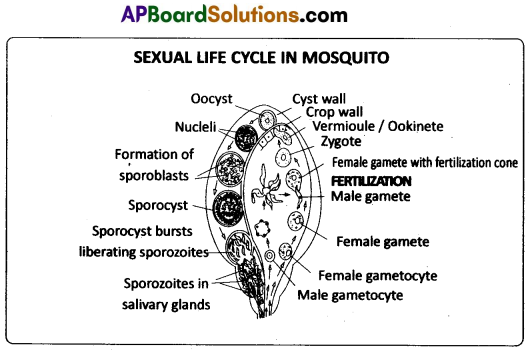
iii) Formation of ookinete and oocysts : The zygote remains inactive for some time and then transforms into a long, slender, motile, vermiform ookinete or vermicule within 18 to 24 hours. It pierces the wall of the crop and settles beneath the basement membrane. It becomes round and secretes a cyst around its body. This encysted ookinete is now called oocyst. About 50 to 500 oocysts are formed on the wall of the crop and appear in the form of small nodules. (Sir Ronald Ross identified these oocysts for the first time).
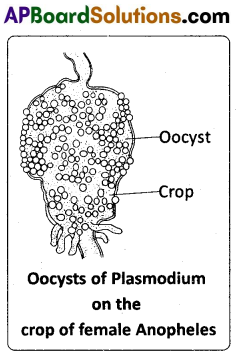
iv) Sporogony : The formation of sporozoites in the oocysts is called sporogony. According to Bano, the nucleus of the oocyst first undergoes reduction division followed by repeated mitotic divisions resulting in the formation of about 1,000 daughter nuclei. Each bit of nucleus is surrounded by a little bit of the cytoplasm and transforms into a sickle shaped sporozoite. Oocyst with such sporozoites is called sporocyst. When this sporocyst ruptures, the sporozoites are liberated into the haemocoel of the mosquito. From there, they travel into the salivary glands and are ready for infection. The life cycle of Plasmodium in mosquito is completed in about 10 to 24 days.
![]()
Question 18.
Describe the digestive system of periplaneta in detail with a neat and labelled diagram.
Answer:
The digestive system of cockroach consists of an alimentary canal and the associated glands. The preoral cavity, surrounded by the mouth parts, is present in front of the mouth. The hypopharynx divides it into two chambers called cibarium (anterior) and salivarium (posterior).
Alimentary canal : The alimentary canal of cockroach is a long tube and is coiled at some places. lt extends between the mouth and the anus. It is divided into three regions, namely, foregut or stomodaeum, midgut or mesenteron and hindgut or proctodaeum. The foregut and hindgut are internally lined by ectoderm. The mesenteron is lined by the endodermal cells.
Foregut of stomodaeum : The foregut includes pharynx, oesophagus, crop, and gizzard. It is internally lined by a chitinous cuticle. Mouth opens into the pharynx, which in turn leads into a narrow tubular oesophagus. The oesophagus opens behind into a thin walled distensible sac called crop. The crop serves as a reservoir for storing food. Its outer surface is covered by a network of tracheae.
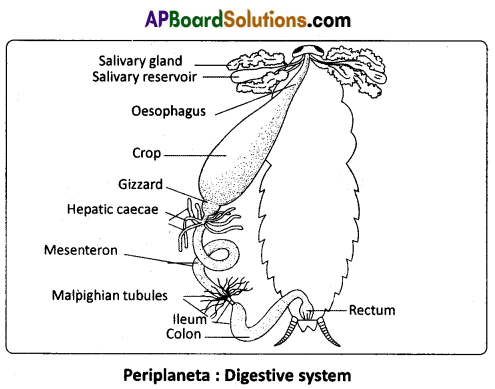
Behind the crop there is a thick walled muscular proventriculus, or gizzard. The chitinous inner lining of the gizzard has six powerful teeth, which form an efficient grinding apparatus. Behind each tooth is a hairy pad, which bears backwardly directed bristles. Among these plates, food is thoroughly ground into fine particles. These food particles are filtered by the bristles. The gizzard thus acts both as a grinding mill and also as a sieve. There Is a membranous projection of the gizzard into the mesenteron in the form of a funnel called stomodeai valve. This valve prevents the entry (regurgitation) of food from the mesenteron back into the gizzard.
Midgut (mesenteron or ventriculus) : The midgut is a short and narrow tube behind the gizzard. It is also called mesenteron or ventriculus. Between the ventriculus and the gizzard, arising from ventriculus, there are six to eight finger like diverticula called hepatic caecae. They are helpful in digestion and absorption of the digested food materials. Ventriculus is functionally divided into an anterior secretory part and a posterior absorptive part.
The secretory part of the ventriculus has many gland cells and it secretes several enzymes. The ‘bolus’ of food in the mesenteron is enveloped by a chitinous and porous membrane called peritrophic membrane, which is secreted by the funnel like stomodeal valve of the gizzard.
Digested food is absorbed into the blood through the peritrophic membrane in the posterior absorptive region of the ventriculus. The peritrophic membrane protects the wall of the ventriculus from hard food particles in the food. The opening of the ventriculus into the hindgut is controlled by a sphincter muscle. It prevents entry of undigested food and uric acid from the hindgut into the midgut.
Hindgut or proctodaeum : The hindgut is a long coiled tube, consisting of three regions namely ileum, colon and rectum, it is internally lined by chitinous cuticle. The ileum that lies behind the mesenteron is a short tube. Six bundles of fine yellow, blind tubules called malpighian tubules open into the ileum near the junction of mesenteron and ileum. Malpighian tubules are excretory in function. Ileum collects uric acid from the malpighian tubules and undigested food from the mesenteron. Ileum opens behind into a long coiled tube called colon. Colon leads into a short and wide rectum, which opens out through the anus. Rectum bears on its inner side six longitudinal chitinous folds called rectal papillae. They are concerned with the reabsorption of water from the undigested food.
Digestive glands : The digestive glands associated with the alimentary canal of cockroach are salivary glands, hepatic caecae and glandular cells of the mesenteron.
Salivary glands : There is a pair of salivary glands attached to the ventrolateral sides of the crop, one on each side. Each salivary gland has two lobes. Each lobe of salivary gland has many lobules called acini. Each acinus is a group of secretory cells called zymogen cells with a small ductule. The ductules of both the lobes of a salivary gland unite to form a common salivary duct on each side.
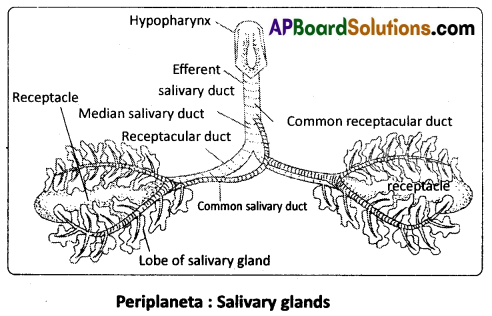
The two common salivary ducts are joined to form the median salivary duct. Between the two lobes of a salivary gland of each side is a sac called salivary receptacle that stores saliva. It leads into a receptacular duct, or ‘reservoir duct’. The receptacular ducts of both the sides are united to form a common receptacular duct, or ‘common reservoir duct’. The median salivary duct opens into the common receptacular duct. Later these two form an efferent salivary duct. The efferent salivary duct opens at the base of the hypopharynx. Acinar cells secrete saliva, which contains starch digesting enzymes such as amylase.
![]()
Question 19.
Describe the different types of food chains that exist in an ecosystem.
Answer:
Energy flows into biological systems (ecosystems) from the Sun. The biological systems of environment include several food levels called trophic levels. A trophic level is composed of those organisms which have the same source of energy and having the same number of steps away from the sun. Thus a plant’s trophic level is one, while that of a herbivore – two, and that of the first level carnivore – three. The second and third levels of the carnivores occupy fourth and fifth trophic levels respectively.
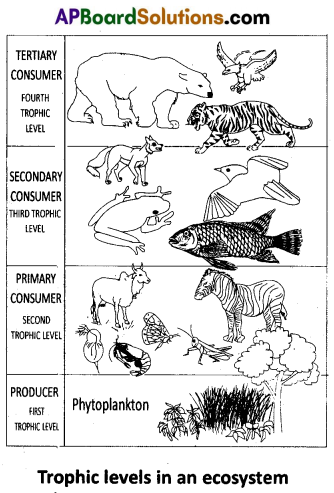
A given organism may occupy more than one trophic level simultaneously. One must remember that the trophic level represents a functional level. A given species may occupy more than one trophic level in the same ecosystem at the same time; for example, a sparrow is a primary consumer when it eats seeds, fruits, and a secondary consumer when it eats insects and worms.
The food energy passes from one trophic levels to another trophic level mostly from the lower to higher trophic levels. When the ‘path of food energy is ‘linear’, the components resemble the ‘links’ of a chain, and it is called ‘food chain’. Generally a food chain ends with decomposers. The three major types of food chains in an ecosystem are Grazing Food Chain, Parasitic Food Chain and Detritus Food Chain.
I. Grazing Food Chain (GFC): It is also known as predatory food chain. It begins with the green plants (producers) and the second, third and fourth trophic levels are occupied by the herbivores, primary carnivores and secondary carnivores respectively. In some food chains there is yet another trophic level – the climax carnivores. The number of trophic levels in food chains varies from 3 to 5 generally. Some examples for grazing food chain (GFC) are given below.
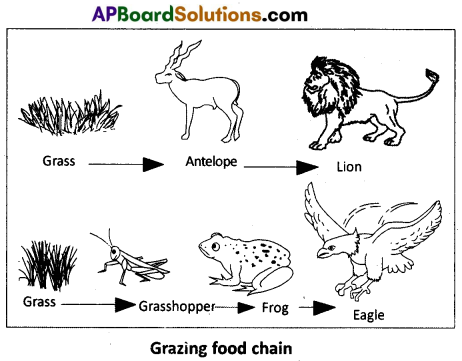

II. Parasitic food chain : Some authors included the ‘parasitic Food Chains’ as a part of the GFC. As in the case of GFCs, it also begins with the producers, the plants (directly or indirectly). However, the food energy passes from large organisms to small organisms in the parasitic chains. For instance, a tree which occupies the 1st trophic level provides shelter and food for many birds. These birds host many ectoparasites and endo-parasites. Thus, unlike in the predator food chain, the path of the flow of energy includes fewer, large sized organisms in the lower trophic levels, and numerous, small sized organisms in the successive higher trophic levels.
III. Detritus Food Chain : The detritus food chain (DFC) begins with dead organic matter (such as leaf litter, bodies of dead organisms). It is made up of Decomposers which are heterotrophic organisms, mainly the ‘fungi’ and ‘bacteria’. They meet their energy and nutrient requirements by degrading dead organic matter or detritus. These are also known as saprotrophs (sapro : to decompose)
Decomposers secrete digestive enzyme that breakdown dead and waste materials (such as faeces) into simple absorbable substances. Some examples of detritus food chains are :
-
-
- Detritus (formed from leaf litter) – Earthworms – Frogs – Snakes.
- Dead animals – Flies and maggots – Frogs – Snakes.
-
In an aquatic ecosystem, GFC is the major ‘conduit’ for the energy flow. As against this, in a terrestrial ecosystem, a much larger fraction of energy flows through the detritus food chain than through the GFC. Detritus food chain may be connected with the grazing food chain at some levels. Some of the organisms of DFC may form the prey of the GFC animals. For example, in the detritus food chain given above, the earthworms of the DFC may become the food of the birds of the GFC. It is to be understood that food chains are not ‘isolated’ always.